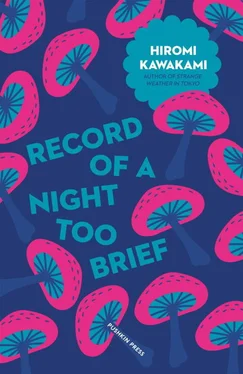Before my brother no. 1 went missing, it was Goshiki.
Goshiki, the name of which is properly written with the Chinese characters  , meaning “five colours”, is a ceramic jar, a family heirloom that had been passed down through a venerable line that I imagine dates back to well before any living person can remember. It’s a great hulk of a jar, and it is claimed that the spirit of one of our forebears inhabits it. The person who started this claim was my grandfather, and at first no one believed him, but he kept saying it and after a while it became an accepted fact that Goshiki was inhabited by a spirit.
, meaning “five colours”, is a ceramic jar, a family heirloom that had been passed down through a venerable line that I imagine dates back to well before any living person can remember. It’s a great hulk of a jar, and it is claimed that the spirit of one of our forebears inhabits it. The person who started this claim was my grandfather, and at first no one believed him, but he kept saying it and after a while it became an accepted fact that Goshiki was inhabited by a spirit.
Goshiki was so big, it took up nearly half the space of the parlour in our apartment. As children my brothers and I used to try to stand around it with our hands joined, but our arms could never encircle it. It was decorated, as its name implies, with glazes of many colours, and shaped like your typical jar from somewhere in Asia. When my mother put my brother no. 1 to bed, she would say that Goshiki spoke when everyone was fast asleep. My brother no. 1 then started claiming he heard Goshiki speak. Kuma-nori, kuma-nori were the words he heard Goshiki speak. Three years later, my brother no. 2 started claiming the same thing. My brother no. 2, however, claimed that Goshiki said not kuma-nori , but kuma-nara . Then, four years later, Goshiki started speaking to me, saying kuna-nira . At that point my mother explained that no one but the three of us had actually ever heard Goshiki say a word. Since Goshiki was now not only inhabited by a spirit but had also started to make utterances, we should perhaps have started referring to it with a little reverence, as Goshiki- sama , but we felt more comfortable with plain old “Goshiki” so we continued to refer to it in our old familiar way.
It was the task of the male head of the family to clean and polish Goshiki. Before my father it had been my grandfather, and before him my great-grandfather. Every day Goshiki would be wiped clean, and once a month a special polishing fluid would be used to give it a sheen. In my greatgrandfather’s day the polishing methods were rather willynilly, and people seem to have been happy to leave Goshiki for several months just to gather dust, but as the decades passed the procedure got more formalized and codified.
My brother no. 1 had been next in line to inherit the role of Goshiki-polisher.
It was the day after a once-monthly polishing ritual that Goshiki vanished without a trace.
We were awakened by a shriek from my brother no. 2, who was always the earliest of us all to rise. One after another we ran out of the bedroom where we slept in our hammocks.
My brother no. 2 was in the parlour, his legs planted firmly on the floor, one arm straight up in the air, the other pointing at the empty space.
“Goshiki’s gone! Goshiki’s gone!” he was shouting, repeatedly. My father and brother no. 1, with open hands, patted the space where Goshiki had been, but no sense of Goshiki’s presence was to be found. After half an hour of the family futilely hunting high and low we abandoned the search. Meanwhile, my brother no. 2 was still shouting, “Goshiki’s gone! Goshiki’s gone!”—sounding like some sort of automated alarm, and finally my mother had to shut him in a closet to muffle the sound.
When my brother no. 1 disappeared, no one yelled out his name or made any concerted effort to look for him.
After that, we saw neither hide nor hair of Goshiki again. But my brothers and I did sometimes hear its voice. In the dead of night when I got up to go and relieve myself, I would hear the refrain kuna-nira, kuna-nira waft down from above. When I walked to the end of the road lined with cypresses to go and draw water from the well, I would hear kuna-nira, kuna-nira float down from between the branches.
On days when I heard Goshiki speak, something slightly out of the ordinary would always happen. A full moon. Rumblings of thunder. Masses of tiny ants on the walls.
The family etched Goshiki’s name in simple katakana into a wooden post in the corner, and before long we started to gather there in the morning, clap our hands to summon Goshiki’s spirit, and pray.
After Hiroko and my brother no. 2 were married, Hiroko would come to live with us. This meant that we would be a family of six: officially, then, within three months of the wedding, one of us would have to leave. Hiroko’s family would be reduced to four, which meant they would, officially, have to take in someone new. Simply balancing out the numbers by making a convenient inter-family swap is not allowed. It’s taboo. It would have been out of the question, for example, if Hiroko had married my brother no. 1, for my brother no. 2 to go over to her family and take her place.
I am not certain when this rule of families having to consist of five members came into existence. But it seems to have been in place when my mother’s younger brother got married and his wife came to live with the family. This was the reason my mother was required to move out of the family home. Because an inter-family swap was out of the question, my mother had to go to live with a family of complete strangers who resided three streets away. After a five-year stay with them, she married my father, in a match arranged by Ten.
Nevertheless, to follow official procedures so closely and actually to move out like my mother did is now rather unusual. These days people rarely follow rules so literally, and false claims of a family having five members are common. So I doubt that when Hiroko does come to live with us anyone will really have to leave, and Hiroko’s family probably won’t bother to take in anyone new, either.
I suspect that the rule of a family having five members became a dead letter almost as soon as it was posted. If anything, it’s probably true to say that families—like my own and Hiroko’s—that have five members are the exception rather than the norm. One can easily encounter families having as many as fourteen people living under one roof, and others consisting of just a single individual.
Certain families also keep pipe foxes for company. These are mythical foxes endowed with magical powers that ascetic mountain priests in olden times kept in bamboo pipes and carried with them on their travels. About twenty years ago, my mother tells me, it was all the rage to keep pipe foxes as pets.
“Twenty years ago,” my mother says, sighing, “that was just when I was a newly-wed. My longing to have a pipe fox as a pet was almost unbearable.”
Hiroko’s family were said to have three pipe foxes, which may be one reason why my mother and my father were so keen to have her as their daughter-in-law.
At that time, my mother tells me, there were advertisements for pipe foxes tacked up all over the block, and it was possible to buy them with a mail-order purchase, cash on delivery. Make an order, and you’d get a pipe fox delivered in a box. The family who lived next door did that, and one day when my mother had returned from shopping and was in the middle of opening her front door the next-door wife came out and told her about it, in some detail. “It’s surprisingly well behaved for its size,” she said, “it doesn’t howl, and you can put it away in a pipe that’s only ten-by-two centimetres! When you touch it, it emits sparks, and if you leave it alone, it frolics about by itself. Our pipe fox has done wonders for the happiness of our home life. My husband drew up an ambitious proposal for his work—which is to do with vegetables, you know—and he got it accepted. And the children submitted artwork to the residents’ art exhibition, and they won top prizes. But the best thing of all is, pipe foxes have a marvellous smell!”
Читать дальше

 , meaning “five colours”, is a ceramic jar, a family heirloom that had been passed down through a venerable line that I imagine dates back to well before any living person can remember. It’s a great hulk of a jar, and it is claimed that the spirit of one of our forebears inhabits it. The person who started this claim was my grandfather, and at first no one believed him, but he kept saying it and after a while it became an accepted fact that Goshiki was inhabited by a spirit.
, meaning “five colours”, is a ceramic jar, a family heirloom that had been passed down through a venerable line that I imagine dates back to well before any living person can remember. It’s a great hulk of a jar, and it is claimed that the spirit of one of our forebears inhabits it. The person who started this claim was my grandfather, and at first no one believed him, but he kept saying it and after a while it became an accepted fact that Goshiki was inhabited by a spirit.
![Хироми Каваками - Strange Weather in Tokyo [= The Briefcase]](/books/29150/hiromi-kavakami-strange-weather-in-tokyo-the-br-thumb.webp)



![О Генри - Недолгий триумф Тильди [The Brief Debut of Tildy]](/books/415353/o-genri-nedolgij-triumf-tildi-the-brief-debut-of-thumb.webp)






